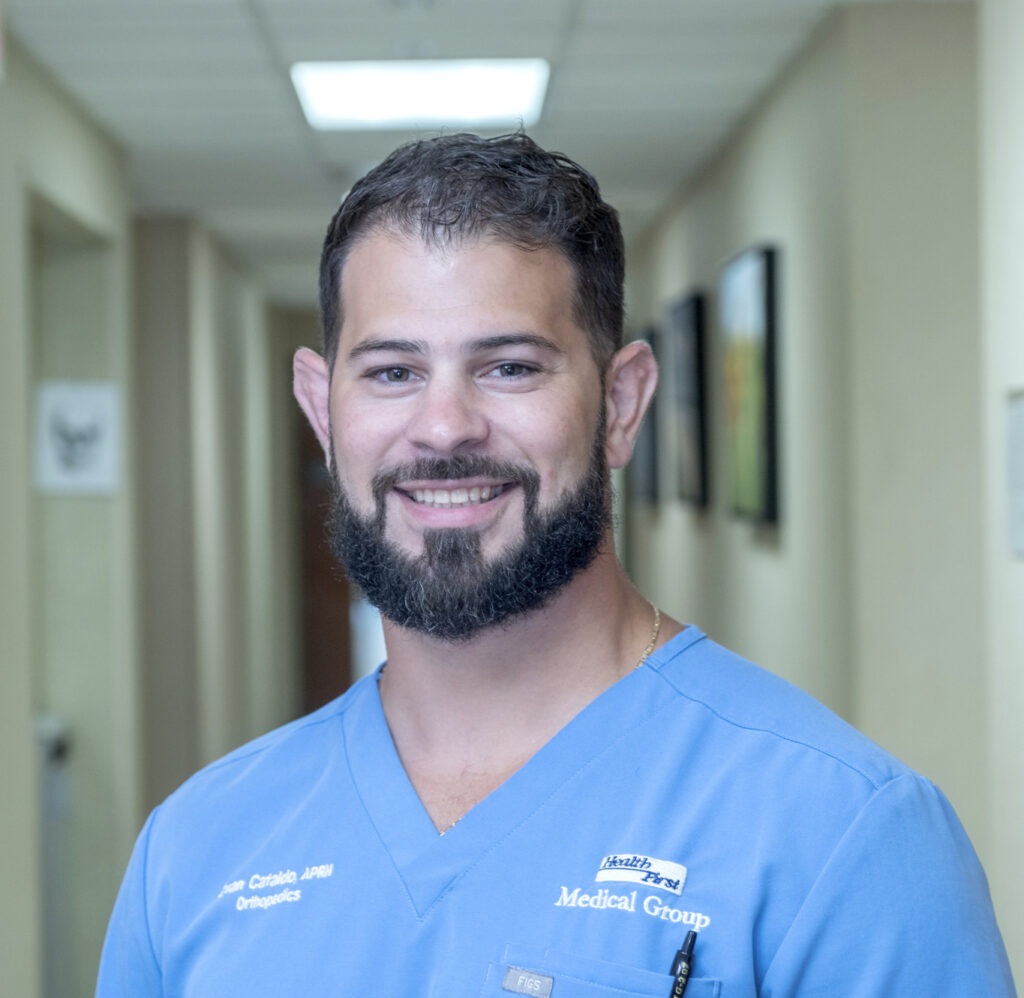Your knees and hips are your largest joints. They support your body’s weight and must work in close coordination to provide the mobility most people take for granted – until injury, arthritis or other problems interfere.
Experts say it is important to do regular exercise to strengthen the muscles around your knees and hips because strong muscles can help support and protect these joints, keeping them healthy and functional despite the aging process.
Evan Cataldo, an orthopedic advanced practice registered nurse with Health First Medical Group, notes that if your joints are painful, you should get a medical diagnosis before you start to work out or exercise. “You want to make sure you’re not going to make your situation worse by doing things that aren’t appropriate.”
Strong hips and knees can improve quality of life by reducing pain, increasing activity, and enhancing body awareness and control. Hip and knee strengthening exercises can also help with balance and stability, posture – and even mood.
Cataldo adds, “That strength is important for everyday activities, including walking, going up and down stairs, getting out of a chair, standing up off the floor, and jumping.”
The Hospital for Special Surgery (HSS) explains that the hips are the strongest area of the body, which is a good thing, since they bear the brunt of the load when it comes to standing, sitting and stabilizing.
When the hips are tight – which for most people is much of the time, since so many of us sit for so long – it puts stress on the joints above and below, in the lower back and the knees.
This can cause pain and alter your posture and gait, which can lead to injuries.
Your hips will have an easier time supporting your body weight if your quadriceps, glutes, hamstrings and abdominal muscles are strong. Cataldo explains that you should do gentle strengthening exercises. “High-impact, heavy weight exercises are not what we want to be doing here. The goal is to function effectively and with minimum pain.”
The HSS website lists seven hip strengthening and flexibility exercises with easy-to-follow directions on how to do them. The exercises can be found here: https://www.hss.edu/article hip-strengthening-exercises.asp.
NASA Bone & Joint Specialists, located in Houston, suggests that instead of a strenuous run, you should try walking or riding your bike at a medium pace to benefit your knees and hips.
These low-impact aerobic exercises help stabilize the hip joints, making them the perfect option to help prevent surgery.
Mayo Clinic states that strong knee muscles can help prevent injuries and manage overall health by stabilizing and protecting joints, relieving pain and improving mobility. Strong quadriceps muscles can make it easier to walk, run, jump and squat. Muscle flexibility can help you achieve a full range of motion.
Cataldo says that resistance bands are a terrific way to add an additional form of exercise.
“There are fewer injuries from the bands than from free weights,” he explains. Resistance bands are thick, elastic bands made of rubber or similar materials that are used to strengthen muscles and bones. They can be used for a variety of exercises and are available online or in sporting goods stores.
Knee exercises should both strengthen and stretch the muscles and ligaments around the knee. AARP says “motion is lotion for ouchy knees” and lists eight that are easy-to-do-at-home on its website: www.aarp.org/health/healthy-living/info-2022/exercises-for-knee-pain.
The Arthritis Foundation suggests you hit the pool and take your workout to the water. Exercising in a pool provides nearly instant relief from pain and stiffness. Even if you don’t feel comfortable walking on land, the buoyancy of water gives you freedom of movement while providing support.
Recommended water temperature for warm water exercise is 83 to 90 degrees. Most people find temperatures in this range to be comfortable and soothing for sore joints and muscles, which makes exercise easier. In general, the slower the exercise movements, the warmer the water needs to be for most people.
Exercise in the water has special benefits:
- The water supports your weight, reducing stress on your joints.
- You can try out exercises in a supported environment before doing them on solid ground.
- You can increase range of motion and endurance without strenuous effort or joint pain.
Be sure to do leg resistance exercises two to three times per week to strengthen supportive muscles around the knees. Strengthening muscles through these activities will dampen stress that travels through the knee.
“Take care of your body in general,” Cataldo suggests. “Put the right stuff in it and stretch every day. Don’t wait too long to get checked if you’re dealing with pain. If it doesn’t abate after a week, it’s time to get it checked by a medical professional. We can’t control our heredity, but we can eat foods that aren’t inflammatory and make sure we are exercising in a beneficial way.
“Youth thinks nothing of health,” he adds, “but old age thinks of nothing else.”
Evan Cataldo, APRN, is a Health First Medical Group Advanced Practice Registered Nurse in Orthopedics. He earned his Master of Science degree as a family nurse practitioner from Chamberlain College of Nursing in Addison, Illinois, and was board certified in 2016 by the American Academy of Nurse Practitioners. He has practiced in sports medicine centers and Health First’s Center for Joint Replacement in Melbourne. He is accepting new patients at Health First Medical Group–Malabar, 730 Malabar Road, Suite 1A, Malabar. The phone number is 321-312-3469.

